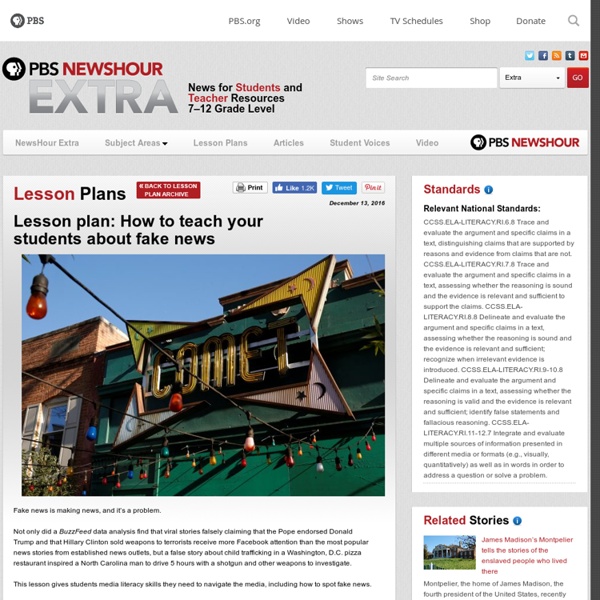*Truth, truthiness, triangulation: A news literacy toolkit for a “post-truth” world
We were guaranteed a free press, We were not guaranteed a neutral or a true press. We can celebrate the journalistic freedom to publish without interference from the state. We can also celebrate our freedom to share multiple stories through multiple lenses. But it has always been up to the reader or viewer to make the reliability and credibility decisions. It is up to the reader or viewer to negotiate truth. News literacy is complicated.
Reading 7-9 ⋆ WebEnglish.se
Salem Witch Hunt WebEnglish.se has added a reading chapter, activities and a relevant YouTube series about the Salem Witch Hunts in 1692 in Intermediate 7-9. Scroll all the way down to Chapters. There are two levels: EZ (easy) for year 8-9 and a longer one for a stronger year 9 or possibly Eng… In "Teaching Matters"
Lesson 1: Finding news - BBC School Report
Image copyright BBC SCHOOL REPORT This lesson explains what makes a story newsworthy and how to go about finding news. Students will be introduced to the idea of writing for a specific audience and are also taught about the sources journalists use to make sure their reports are truthful and accurate. OVERVIEW AND RESOURCES (all require internet access)
News and Media Literacy: Building Critical Consumers and Creators
Presented by Kelly Mendoza, Senior Director of Learning and Engagement, Common Sense Education Hosted by Common Sense Education and Sponsored by Symantec If you attended the live session, you’ll be emailed a CE certificate within 24 hours of the webinar. If you view the recording and would like a CE certificate, join the Digital Learning & Leadership community and go to the Webinar Archives folder to take the CE quiz.
Teaching Digital Literacy
Presented by Michelle Luhtala, Head Librarian, New Canaan High School, CT; and Joyce Valenza, Assistant Teaching Professor, Rutgers University, MI Program Sponsored by Mackin Educational Resources If you attended the live session, you’ll be emailed a CE certificate within 24 hours of the webinar. If you view the recording or listen to the podcast and would like a CE certificate, join the Emerging Tech community and go to the Webinar Archives folder to take the CE quiz. This webinar focuses on instructional strategies that help students increase their digital literacy. Michelle Luhtala, Library Department Chair, New Canaan High School, CT, outlines distinctions between media literacy and digital literacy, and highlights how each can be addressed in the classroom and through the library program.
Turn Students into Fact-Finding Web Detectives
Fact-Checking Tips and Tools for Teachers and Students Show students where to look for credible information on the web. Explain that professional fact-checkers may already have done this important work for us. Use the resources below as references for finding vetted and fact-checked information.
Anima Mundi TED-Ed Animation Workshop: Write a ‘note to self’ and animate it
The International Animation Festival of Brazil, Anima Mundi, takes place every year in Rio de Janeiro and São Paulo. In the 25 years since it was created by four Brazilian animators, Anima Mundi has exhibited more than 9,000 films from 70 different countries to an audience of 1.2 million people. The festival is unique in its approach to community engagement, offering free stop-motion, pixilation, and zoetrope-making workshops to kids and families — while also taking over the city center with animation installations, and distributing a selection of animated shorts to smaller towns and cities across Brazil. Festival leaders also organize the ‘Anima Forum’, which offers masterclasses, feedback sessions, and professional networking opportunities for Brazilian animators and filmmakers. What’s your ‘note to self’ to read in 5 years?
Did Media Literacy Backfire? – Data & Society: Points
Update: On March 9, 2018, I gave a talk expanding on my ideas in this post after a year of reflection/research. You can read the talk crib and watch the video at here: “You Think You Want Media Literacy…. Do you?”
English Fishbowl/Socratic Seminar Discussion – The Canswedian English Teacher
Ahhh… the fishbowl assignment. I saw an English teacher do this with her class once a long time ago, and was immediately hooked. Why is this is my absolute, most favourite assignment to give students? It covers an insane amount of knowledge requirements – understanding, showing understanding, using strategies for listening and reading, choosing text and spoken language from different media and using it in their own production… the list goes onAuthentic speech – It makes students think on their feet and interact with each otherEvidence – students have to prove their point with evidence and sourcesNews – the students read the news, and use facts to back up their argumentsCritical thinking skills – students move away from just memorizing facts (rote learning), and move towards using higher level thinking
MediaBreaker Critical Remix Tools - The LAMP
Break-a-thons are short-term programs with The LAMP, and a perfect introduction for youth about how, why and for whom media are made. Each Break-a-thon focuses on a theme, like the Super Bowl, the MTV Video Music Awards, movie trailers or political advertising; youth then come together for one or two days to break media related to the theme. Participants compete in challenges throughout the event, win prizes and create their very own broken videos talking back to mass media. Past students tell us they never watch TV in quite the same way once they’ve done a Break-a-thon! With Break-a-thon in a Box, you have everything you need to host your own event, including tips, samples, templates and more, all at no cost. Plus, we’re always here to help.
The Critical Thinking Skills Cheatsheet [Infographic]
Critical thinking skills truly matter in learning. Why? Because they are life skills we use every day of our lives.



